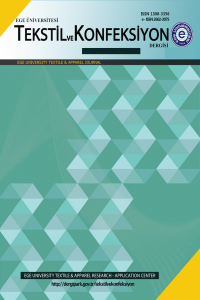COMPARISON OF SPECTROPHOTOMETRIC AND DIGIEYE COLOUR MEASUREMENTS OF WOVEN FABRICS
COMPARISON OF SPECTROPHOTOMETRIC AND DIGIEYE COLOUR MEASUREMENTS OF WOVEN FABRICS
Colour measurement, spectrophotometer,
___
- 1. Z. Khatri, G. Y. Sheikh, K. M. Brohi, A. A. Uqaili, Effective Colour Management for Textile Coloration- An instrumental way towards perfection, Proceedings of the 2011 International Conference on Industrial Engineering and Operations Management, Kuala Lumpur, Malaysia, 2011, pp. 1073–1079.
- 2. Nussbaum P., Colour Measurement and Print Quality Assessment in a Colour Managed Printing Workflow, Doctoral Dissertation, Department of Informatics University of Oslo, Norway, 2010.
- 3. Fan J., Lau L., Hunter L., Appearance issues in garment processing, chapter in: Engineering apparel fabrics and garments, edited by Fan J., Hunter L., Woodhead Publishing Limited 2009, pp. 131–160.
- 4. Anderson K., Selecting the Correct Sewing Thread, 2009 available at: www. texexchange.com>.
- 5. Matusiak M., Walawska A., Important Aspects of Cotton Colour Measurement, FIBRES & TEXTILES in Eastern Europe 2010, Vol. 18, No. 3 (80) pp. 17–23.
- 6. Ngo L. L., Colour matching system for colour approval of multi-component apparel, The Hong Kong Polytechnic University, 2012, available in: www.lib.polyu.edu.hk on 16.02.2015.
- 7. Cheng L., Ghorashi H., Duckett K., Zapletalova T. Watson M. D., Colour Grading of Cotton. Part II: Colour Grading with an Expert System and Neural Networks, Textile Research Journal 69 (12), 1999, pp. 893 - 903.
- 8. Adamczyk P., Rutowicz J., Frydrych I., Comparative Analysis of Results Obtained from Devices: Macbeth & DigiEye, International Conference STRUTEX’2012, Liberec Czech Republic, 2012.
- 9. Berns S. R., Billmeyer and Saltzman’s principles of colour technology (3rd edition) New York, 2000, A Wiley – Interscience. 10. DigiEye User Guide Version 2.51, VeriVide Ltd., 2010.
- 11. Matusiak M., DigiEye Application in Cotton Colour Measurement, Autex Research Journal 1 (2015), (accepted).
- 12. Lau L. N., Kan C. W., Yuen Marcus C. W., Lau Robert K. W., Study of the Correlation between Solid Colors Measured by Spectrophotometer and DigiEye, The First International Conference on Interdisciplinary Research and Development, 31 May - 1 June 2011, Thailand.
- 13. Colour measurement. Patterns & prints, Information brochure of VeriVide Limited, available at: < http://www.verivide.com> on 17.02.2015.
- 14. Yaoyuneyong G., Effects of Illuminants and Retail Environments on Colour of Textile Fabrics, Ph.D. thesis, College of Human Sciences of The Florida State University, 2007.
- 15. Hirschler R., Electronic colour communication in the textile and apparel industry, REDIGE Vol. 1. No. 1, 2010, pp. 43–61.
- ISSN: 1300-3356
- Yayın Aralığı: Yılda 4 Sayı
- Başlangıç: 1991
- Yayıncı: Ege Üniversitesi
Ozgur ATALAY, Asli ATALAY, Muhammad Dawood HUSAIN
Emel ÇİNÇİK, S. Cansu YILDIZ, Özge YILDIRIM
FAZLA KİLOLU ÇOCUKLARA YÖNELİK ARA BEDEN KALIP ÇALIŞMASI
TÜRK MİNYATÜR KADIN GİYSİ FORMLARININ İYİLEŞTİRİLMESİ
Asif Elahi MANGAT, Lubos HES, Vladimir BAJZİK, Zuhaib AHMAD
PLASMA INDUCED GRAFT POLYMERIZATION OF A FLUOROCARBON MONOMER ON POLYAMIDE 6,6 FABRICS
Melek GÜL DİNÇMEN, Peter J. HAUSER, Nevin Çiğdem GÜRSOY
Nilay ÖRK, Hasan ÖZGÜNAY, Mehmet Mete MUTLU, Ziynet ÖNDOĞAN
KANCALI DOKUMA MAKİNASINDA KENAR TELEFİ UZUNLUĞUNUN GÖRÜNTÜ ANALİZ TEKNİĞİYLE İNCELENMESİ
Rafet AKDENİZ, H. Ziya ÖZEK, Göktekin DURUSOY
WICKING & SORPTION ABILITY ON KNITTED FABRICS: EXPERIMENTAL AND THEORETICAL STUDIES
Nesma Sawsen ACHOUR, Mohamed HAMDAOUI, Sassi BEN NASRALLAH
MODA TASARIMI EĞİTİMİNDE GİYSİ YAPISINI ANLAYARAK YARATICILIĞI GELİŞTİRMEYE YÖNELİK BİR YAKLAŞIM
